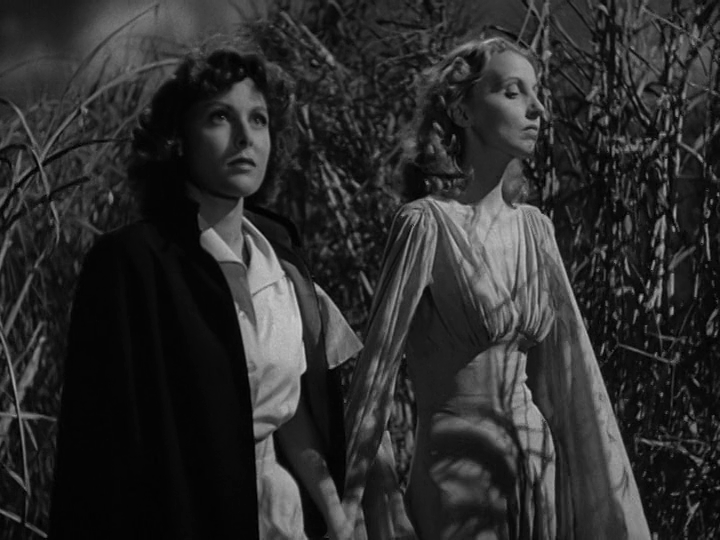A Century of Film is an ongoing series where Devin Wilger watches one movie from each year between 1917 and today. For the year of 1943, it’s I Walked with a Zombie.
The great thing about old B-movies is the lurid titles, the shocking exclamations that are intended to shock passing moviegoers and pack them into the seats out of morbid curiosity. I wonder what they would have made of “I Walked With a Zombie,” which sounds like a thriller about the living dead. One wonders what the audience thought when they were presented with a gothic romance.
There is a zombie, and someone does walk with her, so the title is accurate. It’s not going to be the type of zombie that a modern audience is expecting, George A. Romero’s aggressive living dead, decaying and with a taste for brains, but this was 1943 and Romero was only a toddler. Her look, when introduced, isn’t very far away from a modern zombie, all sunken eyes and sallow skin, but she’s a zombie from folklore, rather than the modern mutation. She is either the result of a high fever wrecking her mind or of a voodoo curse, without any confirmation either way, because ultimately it doesn’t matter. It’s not the actual cause that matters here, just what the characters think the cause might be.
Before we reach the zombie, we meet Betsy (Francis Dee), a Canadian nurse hired to take care of our zombie, Jessica (Christine Gordon). Her job interview, where she’s asked if she believes in witchcraft, should be a red flag. So too should her boat trip to the island of Saint Sebastian in the Bahamas, where she meets her new boss Paul Holland (Tom Conway), who goes out of his way to tell her that there is no beauty on her journey or in the place she’s going. That conversation is later mirrored with conversations with the rest of the population, Saint Sebastian’s beauty is dampened by the pain felt by everyone who lives there. There’s Wesley Rand (James Ellison), Paul’s brother, driven to drink after his affair with Jessica had gone very wrong. There’s their mother (Edith Barrett), guilty because, in spite of her belief in medicine, she can’t help but think she cursed her daughter in law. At one point, Betsy comments to a driver, who has just told her about the way his ancestors arrived at the island, chained to the bottom of a boat to be sold into slavery, “at least they brought you to a beautiful place.” His response - “if you say so” - tells a lot. That the people also cry at the birth of a child and celebrate at someone’s death tells you more - this is an island where existence is defined by pain and cruelty. In such a place, continuing to live long after you are supposed to die would be the greatest pain, and Betsy’s conviction that she should bring her patient back to the world of the living could be read as the ultimate cruelty. Given that she falls in love with Paul, but is trying to bring back his wife, she’s also causing pain for herself.
It is still a horror film, and as a result does have a lot of unsettling imagery as a result. Darby Jones, as the completely blank Carrefour, has to be the most horrifying image in the film, as his role demands that he is a living statue rather than a character. He’s a real person, but lives somewhere in the uncanny valley. Characters running through a field of sugarcane before running into Carrefour is the closest it gets to genuine horror. A scene of a musician walking forward slowly as he sings a folk song about the film’s backstory manages to be as frightening as anything else, both for the intensity of his singing to how he moves slowly forward, breaking down a sense of security in the protagonist - she can’t hide from the mess she’s now embroiled in.
A film about voodoo from the 1940s seems like it could go very wrong - James Bond couldn’t pull off the trick in the 1970s - but while it’s still depicted as very exotic, it’s treated with respect. Voodoo is another symptom of the problems that define the island. Whatever fate has in store, voodoo gives people a feeling of control, and possibly even actual control. If religion is a coping mechanism, then this religion exists to cope with the cruelty that defines everyone’s fate. Cruelty put them on Saint Sebastian, and cruelty brought them together. Voodoo, it seems to posit, is a natural reaction to this cruelty. Cruelty also caused the conflict between the brothers, they believe, and cruelty is what drives the family to believe that voodoo might have more power than they want to admit.
It’s not the film you expect when you read the title. I don’t know if I’d call it strictly a horror film, but it can be very horrifying, and it is very dark. There’s a real pessimism here, a dark outlook on what people do to each other. It’s not coincidence that the island is Saint Sebastian, who is traditionally depicted as being full of arrows. It’s a fitting figurehead for an island where everyone is in perpetual pain. It’s a surprise given what the title tells you, a much smarter film than you would expect for walking with zombies.
Next time, it’s 1944, and we visit the great Billy Wilder and Double Indemnity.



